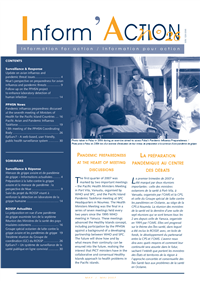Contents
Surveillance & Response
- Update on avian influenza and pandemic threat issues
Seini Kupu (PDF, 102 KB) - Niue’s perspective on preparedness for avian influenza and pandemic threats
Manila Nosa (PDF, 108 KB) - Follow-up on the PPHSN project to enhance laboratory detection of human influenza
Melissa Pontré (PDF, 87 KB)
PPHSN News
- Pandemic influenza preparedness discussed at the seventh meeting of Ministers of Health for the Pacific Island Countries (PDF, 100 KB)
- Pacific Avian and Pandemic Influenza Taskforce
Christelle Lepers (PDF, 107 KB) - 13th meeting of the PPHSN Coordinating Body
Christelle Lepers (PDF, 98 KB)
- EpiSurv7 – A web-based, user friendly, public health surveillance system
Bruce Adlam (PDF, 135 KB)
Editorial
Pandemic preparedness at the heart of meeting discussions
The first quarter of 2007 was marked by two important meetings – the Pacific Health Ministers Meeting in Port Vila, Vanuatu, organised by WHO and SPC, and the Pacific Island Pandemic Taskforce meeting at SPC Headquarters in Nouméa. The Health Ministers Meeting was the final in a series of seven meetings held every two years since the 1995 WHO meeting in Yanuca. These meetings advanced the Healthy Islands concept, including participation by the PPHSN against a background of a developing partnership between WHO and SPC. The future will show how and by what means their continuity can be ensured into the future, realising the interest that PICT ministers have in the collaborative and consensual Healthy Islands approach to health problems in the Pacific islands.
The presentations and discussions at the Port Vila meeting demonstrated how preparations for avian influenza and a flu pandemic are contributing to implementation of the Asia Pacific Strategy for Emerging Diseases. This strategy will make it possible to develop the capacities needed to implement the International Health Regulations. Pacific Island countries and territories (PICTs) continue to show a great deal of interest in pandemic preparedness. The Papua New Guinea delegation set a good example by distributing their plan on CD-Rom. We hope that this will encourage others to do the same – a special page has been set up on the PPHSN website to encourage pooling of experiences and models in this area.
In this issue of Inform’ACTION, we are pleased to publish an article by Manila Nosa, Public Health Director, Niue, summarising Niue’s point of view on preparing for avian influenza and a flu pandemic. He highlights the importance of a multi-sectoral approach, the need to include the national preparedness plan in the disaster emergency plan and the fact that the plan can be used as a springboard for controlling other epidemic outbreaks when needed. Niue, like some other PICTs, has the advantage of being small and needing just one national and multi-sectoral plan. In contrast, other Pacific Island countries have to decentralise their plans at the local level while keeping the multi-sectoral aspects. In fact, in the event of a pandemic, the rapid and multifocal spread of the new virus would, in most cases, require management to be conducted at the local level, although preparations should be made with the experienced assistance of national level administration.
A summary of some of the important points of our current knowledge of avian influenza H5N1 is also presented in this issue.
The first meeting of the Pacific Island Pandemic Taskforce, which brought together representatives of the human and animal health services involved in influenza pandemic preparedness – including the potential spread of the current avian flu outbreak – served to launch the Taskforce and to define its role in this area. A logical decision was made to use existing PPHSN and PHOVAPS mechanisms so as to enable coordination and communication within the group and follow-up of the PRIPPP. Planning for the second year of the PRIPPP will benefit from the guidance of the Influenza Specialist Group and PPHSN Coordination Body.
This meeting was followed by the 13th Meeting of the PPHSN Coordinating Body – a similar meeting for animal health took place at the same time. The most important points of the meeting are presented on page 25. We should note the discussions on the re-emergence of serotype 1 dengue fever, still a subject of interest in the region despite a year’s silence, and the large-scale epidemic that occurred in many countries and territories from 2000 to 2005. It is important to provide more effective, long-term support at the regional level for efforts to control dengue fever, particularly in terms of vector control and community mobilisation to help achieve that control.
This issue also covers an innovative approach to communicable disease surveillance in New Zealand, which was presented to the Coordinating Body and discussed by its members.
Unfortunately, the second quarter of 2007 began with a reminder of the vulnerability of our region to natural disasters. A severe earthquake shook the Western Province of the Solomon Islands, followed by a tsunami to add to the devastation. More than 50 people were killed and many others were reported missing. There was also extensive damage to property, destroying homes and public facilities. After the emergency phase, the threat of outbreaks of diarrhoea-related diseases and malaria had to be considered and appropriate resources put into place to avoid them. This is yet another example of the critical need to be prepared for disasters of both environmental and microbial origin.
Tom Kiedrzynski
SPC Epidemiologist

